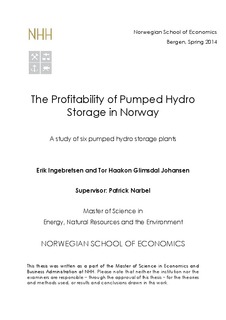The profitability of pumped hydro storage in Norway : a study of six pumped hydro storage plants
Master thesis
Permanent lenke
http://hdl.handle.net/11250/221533Utgivelsesdato
2014Metadata
Vis full innførselSamlinger
- Master Thesis [4372]
Sammendrag
With increasing investments and focus on renewable energy in Europe there has arisen a demand for balancing services due to the intermittency of renewable energy sources like wind and solar power. This thesis examines the profitability of exploiting Norway’s vast reservoir capacity with pumped hydro storage (PHS) to balance and store energy generated by intermittent wind and solar power in Germany. There are substantial costs associated with increasing Norwegian PHS capacity. We have assessed six proposed PHS plants and calculated costs between 66.75 NOK/MWh to 366.56 NOK/MWh, depending on a set of assumptions. To obtain profitability, these costs must be covered by extracting arbitrage from electricity price volatility. PHS plants are introduced stepwise in advanced simulation models to generate price and production data, in order to investigate revenue for PHS owners. Based on the results, there are no findings that support profitability of the six evaluated PHS plants. However, there are reasons to doubt the validity of how the simulation models adjust for the efficiency loss in PHS systems. The thesis’ rejection of profitability opposes a major report from the German Advisory Council (SRU), which states that the arbitrage for Norwegian PHS plants would be a case of high return investment. Moreover, PHS storage may not be needed if German intermittency challenges can be balanced by flexible management of existing hydropower resources. Environmental concerns and uncertainties in future intercontinental transmission lines, and price volatility induced by solar and wind power can also affect future PHS investment decisions. The recommendation to policy makers is therefore not to invest in large scale PHS capability in Norway at this point, but to conduct further research in order to allow for more informed decisions in the future.
